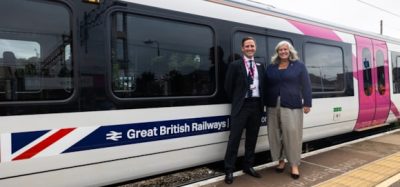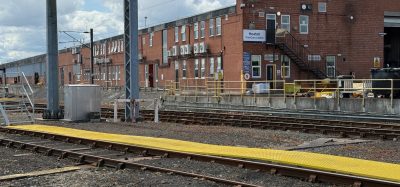Train punctuality in a new perspective
Posted: 2 March 2005 | | No comments yet
There have been numerous projects over the years that have aimed at improving the punctuality of trains. Different levels of ambition have met with varying degrees of success. It can be concluded that the various campaigns and projects have frequently had a directly positive effect on punctuality.
There have been numerous projects over the years that have aimed at improving the punctuality of trains. Different levels of ambition have met with varying degrees of success. It can be concluded that the various campaigns and projects have frequently had a directly positive effect on punctuality.
There have been numerous projects over the years that have aimed at improving the punctuality of trains. Different levels of ambition have met with varying degrees of success. It can be concluded that the various campaigns and projects have frequently had a directly positive effect on punctuality.
However, when the campaign or project has come to an end, the work has failed to result in any really effective and sustainable procedures with which to retain the positive effects that have been achieved. During the period following the quality improvement work, punctuality has gradually deteriorated. Quality work aimed at an improved level of punctuality has instead largely developed into being a descriptive set of punctuality statistics with information on causes of disruptions and attempts to define the problem-owner. Activities aimed at actually solving systematic punctuality problems have been sadly lacking. Being able to work with punctuality matters on a deregulated railway market requires entirely different measures. Banverket has therefore initiated punctuality improvement work in cooperation with the major rail companies that are established in Sweden. This joint punctuality improvement work has been abbreviated to PULS.
PULS has now been in existence since 1998. To begin with, the PULS work was based on joint regional action groups in which, with clear-cut geographical boundaries, talks were held between the parties on disruption causes and measures that were needed in order to improve punctuality. The ambition was that each party, as the problem-owner for the train delays, would understand its role and take its problem to its own company to be solved. The rail companies underwent considerable change during the first few years; new companies were set up and others disappeared. This meant that during the first few years of deregulation, a considerable amount of energy had to be invested in forcing these regional action groups to really function. Not enough energy remained to correct the actual causes of the disruption. As a consequence of deregulation and the fact that companies either grew or decreased in size, there was constant reorganisation within the railway companies. A regional foundation of the punctuality improvement work impaired efforts to guarantee more punctual trains.
Banverket and the railway companies therefore decided to change the direction of PULS activities from 2004. From previously having a regional foundation, the punctuality improvement work is instead based on the different types of transport involved. The actual starting point for the punctuality work is thereby totally different. Previously we measured the punctuality in each region or country border. On the basis of these results we then went on to define the problem-owner and point out who could best handle the matter so that punctuality would improve. The idea was that if everyone did their respective parts correctly, the overall outcome would be good.
Now PULS instead uses the train itself as its basic starting point at the departure station to its arrival at the destination station. We no longer divide up train punctuality by measuring certain region or country borders. Instead, PULS focusses on ensuring that the passengers or freight onboard trains arrive punctually. The new direction adopted for PULS therefore involves looking at all the disruptions that are experienced by a certain train. The approach is organisation-dependent and is based on the quality of the processes that are to some extent involved and affect the train punctuality.
As far as Banverket’s own organisation is concerned, the consequences are obvious. Better and closer cooperation is required between the Administration’s different organisational units.
The new approach means that the work is directed towards taking firm measures instead of subduing symptoms. The analysis work can be carried out in a more structured manner and we now have a greater opportunity to try different solutions and measure their effects on punctuality.
Why are trains not punctual?
In order to be able to work with this question, we have chosen to focus our punctuality improvement work on a limited number of trains and have at the request of train operators introduced the term ‘train list’. This is a list of trains to which the operators feel that both they and Banverket should devote special attention. Although the train list, which serves as an observation list, can be altered, it comprises a maximum of 500 trains throughout the country at any one time. The railway companies have had various selection criteria when choosing the trains to be included on the list. Most of them have chosen trains with punctuality problems, but there are also trains that are today considered to be very punctual but where the operators will probably have very serious problems if they are delayed. The third group of trains are those which the transport operator fears are likely to be given a lower priority by Banverket Traffic if disruptions occur among other traffic.
The railway companies have also been given the chance to specify their own quality targets for the trains so that everyone will know when acceptable quality levels have been achieved. It is also possible for Banverket to include its ‘own’ trains on the list, for example trains that are often delayed and which disturb the traffic scenario for other trains. These ‘banverk trains’ shall also be included on the list for observation purposes. The train list will be gradually changed, although we cannot expect it to be extended in terms of volume.
Specially appointed train administrators are responsible for following up the trains appearing on the train list in order to pinpoint trains that are frequently affected by punctuality problems. The focus is centred on those listed trains that fail to achieve their quality targets, and for which action plans are successively introduced. The train administrators analyse who the likely problem-owner is and who is probably best equipped to be able to remedy the situation.
A special log is kept of which measures have been proposed. Once the measures have been taken, demands are made to check that the measures have led to improvements in punctuality. The train administrators have also been given the task of making sure that questions are referred to immediate superiors if the proposed measures have not been taken by the parties contacted or if the effects of the measures taken are inadequate and no other measures are proposed.
The train administrators acquire a wide contact network among the train operators and track regions, and have to deal with a wide variety of issues that are to be administered and handled by many different parties. In order to be able to deal with the disrupted trains, Banverket has produced a manual to provide method support. The manual is primarily based on methods that can be applied in order to analyse operational disruptions among infrastructure administrations or railway companies and to analyse how robust the timetables are.
The next stage of the work entails the training of Banverket’s train administrators. During the course of this training, discussions will also be held on follow-up and feedback on how the work has progressed so far. A seminar is planned in order, with the railway companies, to discuss possible improvements in working methods and procedures. It will take the form of a joint development seminar with train administrators from both Banverket and the railway companies. Banverket has a high level of ambition to ensure that the work of the train administrators achieves the required outcome. Next to safety, punctuality is Banverket’s most important goal area.
The new Swedish Railway Act, which is based on the EU’s second railway package, stipulates that it shall be possible to follow up rail traffic in such a way that incentive-linked agreements can be made between Banverket and the railway companies in connection with punctuality improvement work. Furthermore, a number of railway companies are eager to make sure, for the sake of their own follow-up work, that changes are made to Banverket’s follow-up system. It should also be added that in an international context, demands are being made from various directions for the infrastructure administrations to solve the question of how to code delay causes so that it is possible to follow up the punctuality of a transport, at least through Europe.
In order to meet these demands, a pre-study is currently in progress to identify the need for a new follow-up system referred to as GIANT. The new system is intended to replace the present information systems TFÖR-TFÖR/Samst, Orup and MAPS.
Next stage in the development of PULS
The idea is that PULS should be further developed and become more active and pro-active. The PULS work in Sweden will be directed towards finding forms for answering the question, what measures are taken today when trains are late? What can we do to mitigate the effects that occur in traffic and which often result to some extent in delays in rail services?
The development requirements we are currently facing concern our ways of dealing with customer questions. During 2004, a pre-study was conducted that looked into the need of establishing a customer service function. The conclusions of the study indicate the need for a customer service function as being in part a symptom of other problems. The basic problems can be divided individually into three parts as far as the operative work is concerned.
The first is the internal decision-making process within traffic control centres. There appear to be shortfalls since no planned or clearly formulated guidelines have been developed in advance on how to deal with different types of disruptions. Special guidelines for major track engineering works were tested during 2004 on traffic in Norrland, and will be evaluated in 2005. A number of guidelines need to be developed on how to deal with various types of deviations. The complexity of these issues has increased since the railways in Sweden were deregulated.
The second problem area is the decision-making process in operative situations that takes place with the traffic control that is conducted together with the railway companies. This process should be developed together with the railway companies. When a disruption occurs, the personnel manning a traffic control centre often have a relatively accurate and comprehensive picture of the traffic situation. In order to be able to take action and determine the optimum decision, the railway companies need to be involved in the decision-making process. The problem is that they do not have the same opportunities to gain an overview of the entire traffic situation. Consequently, it takes longer for them to be able to gain a grasp of which problems are really being described by the traffic controller when he or she contacts them in connection with a disruption. It is difficult for the railway company to know which trains are involved in the delay and are affected by the disruption, where the company’s other resources in the form of personnel or vehicles in the current situation are actually located, or what possibilities exist bearing in mind the fact that the services run by other railway companies restrict the potential for flexibility.
In addition to these production-engineering problems, the railway companies also have to deal with transport purchaser problems. Banverket has introduced a new user interface for the Opera system so that railway companies will be able to gain a better idea of the information situation. The interface will also make it easier for the transport control staff in the different railway companies to communicate with the personnel manning the traffic control centres.
The third area is the actual routines for communication. At present, there is a vast flora of routines among the various railway companies and entirely different handling procedures at the eight traffic control centres. For the sake of integration and increased efficiency, this area now needs to be developed in conjunction with the railway companies gaining access to the new Opera tool.
The conclusions of the customer service function pre-study also take up the matter of how communications are to be effected in connection with applications for train paths in the current bi-annual timetable. However, these issues do not come under the scope of the PULS work.
When is a train considered as being delayed? At present there is no clear definition of this. For certain railway companies the limit is a delay level of two minutes. Other companies have other limits, and Banverket has defined its own quality factor for a train’s punctuality as being a delay of more than four minutes. In an international perspective, we have extremely restrictive quality factors, at least in connection with the transportation of freight.
A proposal needs to be drawn up for quality levels for trains, and Banverket and the railway companies need to reach an agreement on quality levels for individual trains or groups of transport assignments. With relevant quality levels, we have a sound basis for continued work on how the levels are to influence the priorities dictated by train paths in connection with delays at the operative stage.
In the case of other delays that occur, perhaps as a result of the railway companies running trains under conditions other than those planned for or which were not ready for departure at the scheduled departure time, or which have a reduced potential for keeping to schedule, other procedures are needed at the operative stage. Banverket and the railway companies should agree in advance on some form of staged sanction system. It is important for the consequences to be determined in advance regarding ‘what happens if…?’
Is it reasonable for trains to run every day with a delayed departure without Banverket taking any form of action? How should we deal with a train that deviates from the preconditions on which the timetable is based? How do we deal with a train that is being pulled by a locomotive running at decreased power as a result of damage? A well-founded staged sanction system developed jointly by Banverket and the railway companies may in future need to be built into the Network Statement.
There are at present some 7,000 train paths scheduled into the bi-annual timetable. Many of the trains run on different tracks within the country and do not follow the geographical boundaries that are applied by the traffic control centres or the routes that are defined within Banverket. The work performed at a traffic control centre has been increasingly divided into different control areas, which has meant that the chances of gaining a comprehensive overview have successively diminished. Today we can see tangible effects of one traffic controller’s decision in his own area often not being communicated to other train dispatchers who will be subsequently responsible for handling the same train. Priorities that are made in one area may in another area be completely unsuitable. Consequently, development work is needed in order to establish the forms for how we can increase Banverket’s ability among the staff manning traffic control centres to work jointly towards alleviating the impact of delays that have already occurred, and how these decisions are to be communicated to the railway companies concerned.
What measures need to be taken to ensure that today’s delayed transport will not be delayed tomorrow as well? What steps can we take in advance in order to mitigate the impact from the kind of problems we believe will influence transport in the future?
Within this area, Banverket is at present conducting a special research project into the type of weather information the personnel manning a traffic control centre need in order to be pro-active. What types of weather information is it important to receive more detailed forecasts on at an early stage? For example, we know that data on snow quantities in the Stockholm area is important information, whereas for the traffic control centres in the north of Sweden it is more interesting to obtain early information on snow quantities in combination with wind speed. To what extent is it possible to assess the skid level on a line if data is available on air humidity? If you already have information on snow quantity and anticipated temperature, point heaters can be switched on at an early stage so that the points are heated up in good time before it starts snowing, etc.
One future development area should be to review other ways in which the capacity of the traffic control centres to predict disruptions can be improved. In addition, the traffic control centres need to find better ways of communicating anticipated disruptions in advance and to develop procedures for a more pro-active search for information on which to base decisions.
Global Railway Review Autumn/ Winter Issue 2025
Welcome to 2025’s Autumn/ Winter issue of Global Railway Review!
The dynamism of our sector has never been more apparent, driven by technological leaps, evolving societal demands, and an urgent global imperative for sustainable solutions.
>>> Read the issue in full now! <<<







